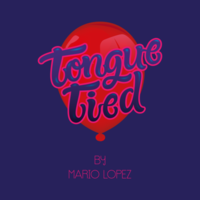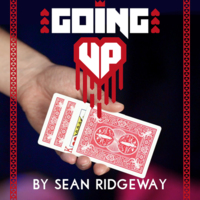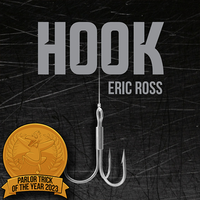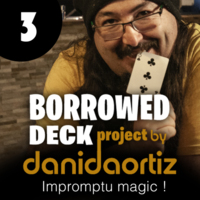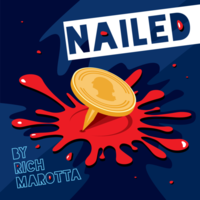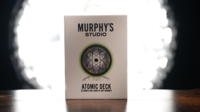Pentagon by Patrick Redford
| Price: | $40.00 |
Pentagon boasts five impromptu routines + a few hidden surprises all featuring some of the coolest super powers around. This is the fourth book in the series of five.
Contents:
Super Hearing - A Sound Phone Call
Using super hearing you're able to tell the exact number of coins your subject is shaking in his hand over a phone line.
X-Ray Vision - X-Ray Vision Coins
Using the power of x-ray vision you're able to tell which hand a borrowed coin is in, it's date, and whether its heads up or tails up.
Mind Reading - Shade Drawing Duplication
An incredibly clean close-up Drawing Duplication combining a clever peek and legitimate muscle reading.
Psychokinetic Power - Staring Sensation
With their eyes closed, two people step into each other's mind and body and think and feel exactly as the other person thinks and feel. Two people can sense when the other is starring at the back of their head, they sense when the other person moves their arms, and anticipate when the other is about to stand.One subject may even think of the exact same word that the other has freely thought of.
Time Travel - The Time Traveler
An entire room notes the time on their watch only to experience the physical sensation of time travel as a business card with the current time written across the face is ripped and burned only to visually un-burn, un-rip, and finally go blank. When everyone looks at their watch again time its verified that somehow the room traveled back through time a full five minutes.
Pages: 48 - Soft cover - 10" x 6.5" - Full-color and black-and-white illustrations
ASK HERE
Featured Magic Tricks
4 star 0%
3 star 0%
2 star 50%
1 star 0%

 Some Good, Some Bad.
Report this review
Some Good, Some Bad.
Report this review
but have only done it a handful of times
and never thought I understood it all
from Banachek's poor teaching.
In other words,
I think the explanation in Banachek's
original manuscript was unclear.
It had diagrams (which is what Pentagon NEEDS), but the diagrams in the original PKT were unhelpful.
There was a drawing of a hand and I was not sure that he really meant me to use my finger in that weird way which doesn't seem right.
Then there was another drawing of a stage, from overhead, with 3 vague figures on it representing the performer and the spectators. When I say "vague figures," I mean 3 circles--not giving any indication which direction they're facing. It made no sense to me.
It seemed to contradict the verbal explanation,
and it didn't make any sense from just looking at it.
It would've helped to put arrows on those large black dots representing the spectators and performer so I could see the direction everyone is facing.
Or maybe there were arrows and it made it even more confusing because it contradicted every performance I'd seen of it.
Pentagon has made much clearer to me, so I'm grateful to Redford for that. Very grateful!
On the other hand, I wish he had used diagrams instead of spending all that time doodling misshapen and irrelevant comic strips that aren't helpful.
There's a section in the PK Touch routine called Staring Sensation. I really need a diagram for this, because the way he describes the "physical method," it doesn't make any sense. There's no way you can anchor the ___ to the bottom of the chair, then "around the back" (around the spectator's back? around the back of the chair? which direction 'around'??) to my left wrist.
An illustration would've been useful here.
There has to be a fulcrum that he forgot to mention, and even then it doesn't sound feasible.
So I guess I'll just figure a method out for myself
(I thought I was paying for that when I got the book).
Another gripe I have with the book is,
in addition to the doodles used as filler,
the words of each chapter title are defined for us,
with dictionary definitions. N
ot obscure words.
Words like, "Time Travel," "Super," "X-ray."
I hate when authors add such patronizing
FILLER
[ ˈfilər ]
noun: filler · plural noun: fillers
a thing put in a space or container to fill it:
There are 21 pages of CARTOONS in this book,
cartoons that add nothing to the instruction,
leaving 27 pages of book.
The advertisement says,
"Pages: 48 - Full-color and black-and-white illustrations."
The truth is if you remove the irrelevant cartoons, the book is 27 pages.
So Patrick added over 20 pages of 'not-a-magic-book'
so he could say he has a ~50 book.
Half of the pages are just doodles from a high school student and don't add anything to the book.
Just makes it more annoying since
you have to flip 3 or 4 pages
every so often to get back to the real book.
One more thing.
The ad says, "Full-color ... illustrations."
That's referring ONLY to the cartoons.
The instructive illustrations regarding the actual tricks, those are black & white line drawings.
Just wanted that to be clear in case
you feel a bit let down when
you find that there aren't really full-color illustrations.
And plus, the one trick where
I needed an illustration or diagram,
PK Power, there was none.
Just paragraph after paragraphs
describing where the performer should stand,
how to seat the participant, where the participants hands should be, that the participants should have their eyes closed, touch the participant on the back...
Even the words are unclear. For example, Redford says, "if you hit the right place on a subject's back, it will create a minor pressure in the head... this is the spot you want to hit." ??? ARE YOU SERIOUS?
So I'll just experiment touching people's backs,
below the shoulder blades,
until eventually I'll find that sweet spot.
A diagram would've been EXTREMELY HELPFUL,
and it would've been so easy for Redford to
stop coloring cartoons and instead
make a simple drawing showing where
on the back I'm supposed to touch the spectator,
instead of just telling me to touch a spectator on the back "somewhere below the shoulder blades."
The back is a large place.
Furthermore, he could've saved several paragraphs
of vague explanation with one illustration,
but there are no illustrations for the PK Power effect.
Ok, I'm going to stop reviewing now since I'm working myself up, realizing how much better this book could've been.

 Unbelievable
Report this review
Unbelievable
Report this review

Act Builder beta





